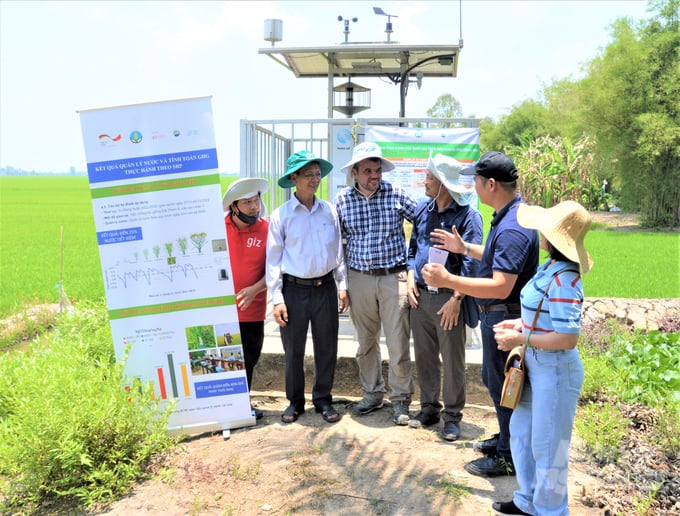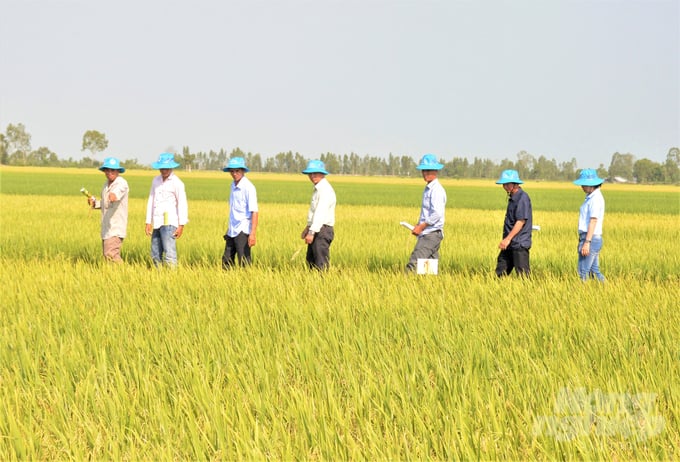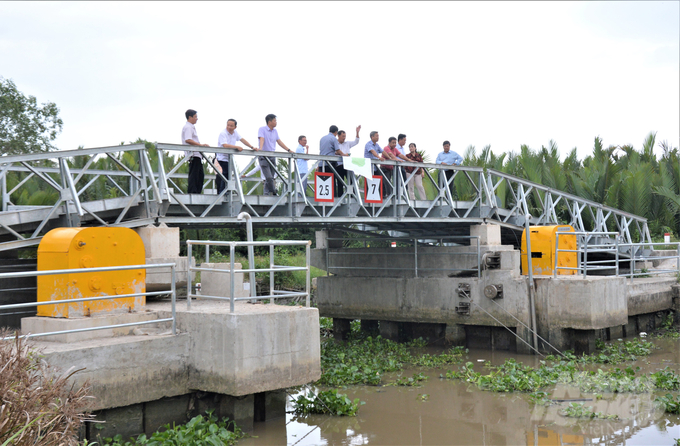May 24, 2025 | 16:22 GMT +7
May 24, 2025 | 16:22 GMT +7
Hotline: 0913.378.918
May 24, 2025 | 16:22 GMT +7
Hotline: 0913.378.918
Although it has ended, the Vietnam Sustainable Agriculture Transformation Project (VnSAT) still leaves a deep mark on the vast rice fields of Tan Hiep district, Kien Giang province. Not only the infrastructure works are invested in, the advanced low-emissions rice production procedures are also maintained by farmers, bringing practical effects.

Participating in the VnSAT project, the Kenh 7A Agricultural Cooperative has invested in a smart station to monitor worm and planthopper and support integrated pest management (IPM), helping to reduce unnecessary pesticide spraying in the field. Photo: Trung Chanh.
Kenh 7A Agricultural Cooperative (Thanh Dong A Commune, Tan Hiep District) is one of the farmer organizations selected to participate in the VnSAT project and still maintains effective activities from the project at present.
According to Do Duy Nguyen, Director of Kenh 7A Agricultural Cooperative, the cooperative currently has 336 members and 640 ha of cultivated area, production and supply capacity of 4,500 tons of raw materials per crop, and many areas are VietGAP-certified.
“When participating in the VnSAT project, members of the cooperative were able to receive training and well performed the rice cultivation procedure “1 must 5 decreases” (1P5G). After the project ended, we continue to maintain the advanced rice production procedure and train more in good agricultural practices (GAP) following the Sustainable Rice Platform (SRP) standards”.

Farmers still maintain advanced low-emissions rice production procedures after the VnSAT project ends, bringing practical effects. Photo: Trung Chanh.
According to Director Nguyen, farmers practice innovative agriculture to increase profits and lessen the impact on the environment by reducing seeds sown, irrigation water, and the use of chemical fertilizers, thus reducing greenhouse gas emissions. Local farmers apply the alternate wetting and drying (AWD) irrigation technique and IPM, calculate emissions volume using tools supported by iRRI, reduce MRL and utilize smart pest monitoring stations to support IPM.
The VnSAT project was implemented in 8 districts and cities of Kien Giang province, including Tan Hiep, Giong Rieng, Chau Thanh, Go Quao, Hon Dat, Giang Thanh, U Minh Thuong and Rach Gia city. During the implementation process, 22 cooperatives received infrastructure investment and technical training for “3 decreases 3 increases” (3G3T) and “1 must 5 decreases” procedures for 53 cooperatives and cooperative groups.

During the implementation process of VnSAT in Kien Giang, 22 cooperatives received infrastructure investment. Photo: Trung Chanh.
Tu Thanh Long, Deputy Director of the VnSAT Kien Giang Project Management Board, said that during the implementation of the VnSAT project, the whole province organized training for 19,242 farmer households on a total farming area of 31,927 ha.
More than 73% of households apply and continue to maintain 3G3T in the field, equivalent to 14,141 households and 25,190 ha of production area, reaching 120% of the proposed plan. The number of households applying 1P5G after the training was 6,355 households (64%), the cultivated area was 11,821 ha, reaching 113% of the plan. The total rice production area that acquires underwriting contracts from businesses is 11,860 ha, reaching 169% of the plan.
“Thanks to the good application of technical processes, now the average rice yield is 7.6 tons/ha, an increase of 1.4 tons/ha compared to before implementing the project. Counting the entire project area of 40,738 ha, VnSAT has helped increase output by more than 57,000 tons of commercial rice, equivalent to more than VND 330 billion,” said Deputy Director Tu Thanh Long.

The community extension force supports farmers to apply sustainable rice production standards, adapt to climate change, reduce greenhouse gas emissions, and improve income. Photo: Trung Chanh.
Le Huu Toan, Deputy Director of Kien Giang Department of Agriculture and Rural Development, said that participating in the scheme "Sustainable development of 1 million ha of high-quality specialized rice cultivation associated with green growth in the Mekong Delta", Kien Giang province has registered with the Ministry of Agriculture and Rural Development to reach 200,000 ha of specialized rice cultivation by 2030.
For the initial stage, the local agricultural sector will implement on an area of 60,000 ha based on the rice area of the VnSAT Project in previous years. After that, it will gradually expand to 100,000 ha by 2025 in the districts of the Long Xuyen Quadrangle.
In order to participate in the scheme and achieve success, Kien Giang Department of Agriculture and Rural Development will form a specialized area for high-quality rice production with a production system organized in accordance with the value chain.
Translated by Samuel Pham

(VAN) The People's Committee of Tra Vinh province has approved an adjustment to the investment policy for the Green Hydrogen Plant project, increasing its area to approximately 52.76 hectares.
![Reducing emissions from rice fields: [2] Farmers’ commitment to the soil](https://t.ex-cdn.com/nongnghiepmoitruong.vn/608w/files/news/2025/05/05/dsc08881jpg-nongnghiep-140632.jpg)
(VAN) Clean rice cultivation model in Thuong Tan commune, Bac Tan Uyen district, is assisting local residents in achieving sustainable agriculture by substantially reducing costs, increasing productivity, and protecting the environment.

(VAN) At the conference to disseminate Resolution No. 68, AgriS introduced its digital agricultural ecosystem and reaffirmed its commitment to accompanying the Government in promoting private sector development and sustainable agriculture.

(VAN) 'Blue Ocean - Blue Foods' initiative is designed to restore marine ecosystems and establish sustainable livelihoods for local communities by cultivating a minimum of 1,000 hectares of cottonii seaweed in the first three years.
/2025/05/21/4642-3-112707_603.jpg)
(VAN) The V-SCOPE project has made direct contributions to three out of six pillars of the Comprehensive Strategic Partnership between Vietnam and Australia.

(VAN) Facing the threat of rabies spreading to the community, Gia Lai province urgently carries out measures to vaccinate dogs and cats on a large scale.

(VAN) Disease-free livestock farming not only protects livestock herds but also stabilizes production and livelihoods for many farmers in Tuyen Quang.